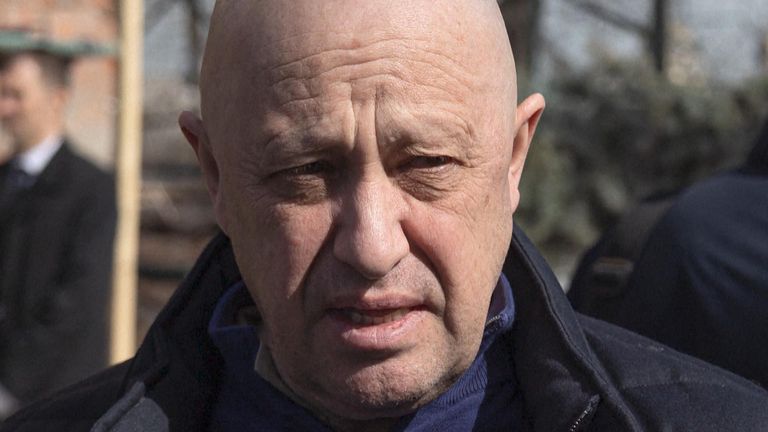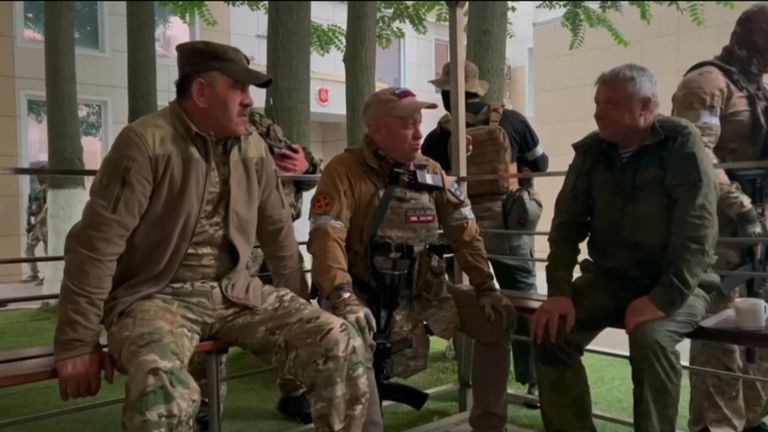The boss of the Wagner mercenary group appears to fancy his chances when it comes to the march on Moscow – something Russian leader Vladimir Putin has called “armed mutiny”.
Troops aligned with the one-time ally of Putin, Yevgeny Prigozhin, have left Ukraine and begun the journey to the Russan capital – something he calls a “march of justice” – in an effort to oust defence minister Sergei Shoigu.
But how does the group of contracted fighters measure up to the power of Russia, which has one of the biggest militaries in the world?
Mystery aircraft leaves Moscow – Ukraine war latest
How many soldiers does the Wagner Group have?
White House officials estimate the private mercenary group employs around 50,000 soldiers – most of them believed to be assigned to Ukraine.
Of those, 40,000 are thought to be convicts who have been employed from prisons in Russia.
While estimates vary, up to 9,000 Wagner troops are thought to have died in the Ukraine conflict, according to US estimates, with around 20,000 injured.
Exactly how many are involved in the march to Moscow is currently unclear.
How many soldiers does Putin have?
Russia’s official military is estimated to be the fifth largest in the world, with roughly one million active personnel.
The country claims most of its fighters in Ukraine are volunteers, with the Institute for the Study of War putting the number of troops there at around 300,000.
Vladimir Putin has called for an increase in troop numbers, as well as the number of reservists.
Western officials have estimated Russia has lost more than 100,000 troops on the battlefield in Ukraine.
Read more
The former hot dog seller and thug who became Wagner boss
Prigozhin was disaster waiting to happen for Putin – analysis
How capable are the Wagner soldiers?
The force used to only take on battle-hardened troops, largely made up of retired Russian fighters up to age 55, but it also includes fighters from other countries.
However, entry conditions have been widened and they now take on anyone willing to kill for them – meaning some may have questionable fighting skills and discipline.
What weapons do Putin’s soldiers have?
The army has access to an arsenal of Russian and Soviet-era weapons.
It includes submachine guns, assault weapons, sniper rifles, grenade launchers, ground to air missiles, tanks, combat vehicles and mines.
Photos show machine guns have been set up on Moscow’s borders as Wagner troops advance.
However, some of Russia’s gear used in Ukraine dates back to the communist era.
Sixty-year-old T-62 tanks and armoured personnel carriers dating back to the 1950s have also been seen, according to a MoD update in March.
Click to subscribe to the Sky News Daily wherever you get your podcasts
What weapons do Wagner soldiers have?
The group has – until now – been fighting alongside Russian soldiers in Ukraine and they have shared weapons including tanks and air defence equipment.
However, Wagner is said to have purchased extra weapons from North Korea.
The US claimed last year that Pyongyang had supplied the group with weapons, including artillery shells, but it denied the speculation as “gossip”.
Some of its military hardware was reportedly attacked by Russian helicopters as it was being transported in convoy towards Moscow on Saturday, according to Prigozhin.
How much do the soldiers get paid?
Wagner boss Prigozhin is wealthy after rising from humble beginnings selling hotdogs to set up a network of businesses.
It’s unclear exactly how much his mercenaries receive – some reports put it at around £9,000 a month, others as low as a few hundred.
Moscow’s troops, meanwhile, were being offered a minimum of 160,000 rubles (£1,522) per month during a recruitment drive in September.
However, independent Russian outlet Vertska believes many have seen delays to payments, or have not been paid at all.




















